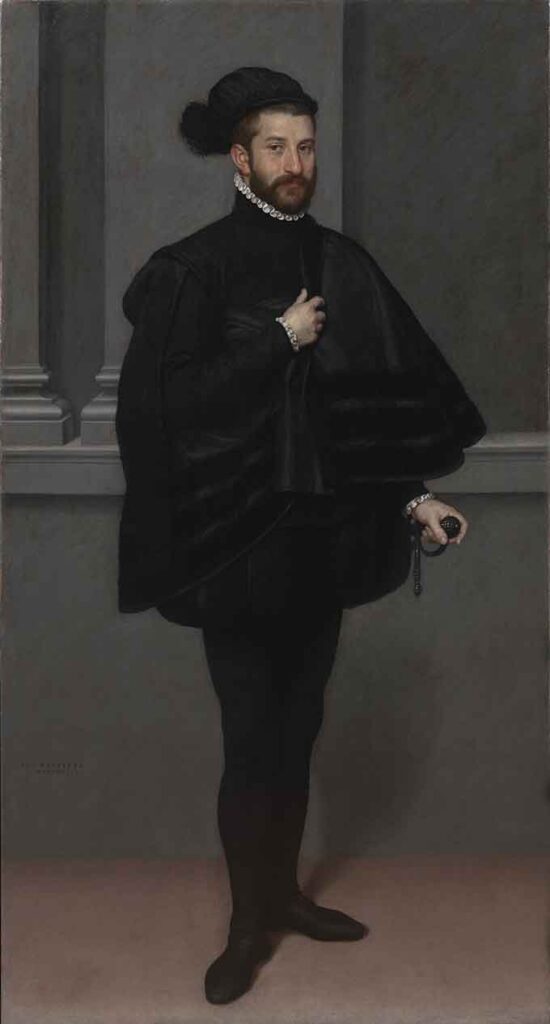The Knight in Black
Giovanni Battista Moroni , ca. 1567
Description

One of the most famous full-length portraits by Giovanni Battista Moroni, this painting came to the Poldi Pezzoli Museum in 2004. Until the 1950s it had been in the well known collection of the counts Moroni of Bergamo, who had amassed a considerable number of important works by this artist – seemingly a family relation –, the majority of which are still in their hands.
Painted life size, the Knight in Black stands out against the grey background, you can see only a few architectural elements: a string course supporting two great pilasters. His extremely elegant dark clothes, which gave the painting its name, have been depicted with great finesse especially the folds in the drapery and the delicate passages of light and shade animating the surface. The face, presented in three-quarter and in full light, emerges from the narrow collar, above the ruffled edge of the white shirt.
The eyes gaze intensely at the spectator, while his white hands, holding a sword hilt and an edge of the short cloak, stand out sharply against the black material. The Knight in Black fully belongs to the series of most beautiful full-length portraits painted by Giovanni Battista Moroni. Datable to the first half of the 1670s, Moroni’s last period, the painting belongs to the artist’s so-called ‘grey style’.
This is characterised by a palette based on tones of black and grey, a formal semplification, and a more perceptive and searching investigation of reality. The identity of the enigmatically smiling young man, who appears to be about 25 or 30 years old, is still unknown.
Data Sheet
Author
Giovanni Battista Moroni, 1520 ca.-1578/1579
Date
ca. 1567
Material and technique
Oil on canvas
Measures
190 cm x 102 cm
Acquisition
Annibale Scotti Casanova bequest, 2004
Inventory number
5240
location
Golden Room
The Golden Room is the most important room in the Museum and houses the masterpieces of painting from the Poldi Pezzoli collection. Conceived according to the dictates of the Renaissance style, it was designed to be the hall of honor of Gian Giacomo’s apartment. After the collector’s death, Giuseppe Bertini carried on the work: unfortunately, both the gilded coffered ceiling, the frescoes, painted by Bertini himself, and the damask fabric decorations that lined the walls were destroyed by bombing. The current museographic arrangement dates back to the 1990s. Among the works on display are the Portrait of a Lady attributed to Piero del Pollaiolo and which has become a symbol of the museum, Bellini’s Imago Pietatis, Botticelli’s Lamentation over the Dead Christ, Mantegna’s Madonna and Child, and Piero della Francesca’s Saint Nicholas of Tolentino. The display case separating the Salone Dorato from the Sala degli Stucchi houses the porcelain and majolica collections.
collection
Paintings
The Museum hosts over 300 paintings. Among them, many Italian works from the Renaissance: masterpieces from Tuscany (Botticelli, Piero della Francesca, Pollaiuolo), Lombardy (Luini, Boltraffio, Solario) and Veneto (Bellini, Mantegna). Important is also the group of 18th century Italian painting (Guardi, Canaletto, Tiepolo, Fra Galgario). In the collection, there are mainly portraits and small size paintings.
